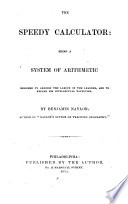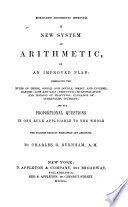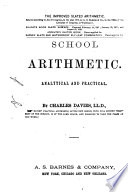 | Thomas Rainey - Arithmetic - 1849 - 320 pages
...Multiply the sum of each payment by its time, add the several payments: then, add their products ; and divide the sum of the products, by the sum of the payments. The several periods of time must be of the same denomination ; tither days, months, or y'ars,... | |
 | Benjamin Naylor - 1850 - 334 pages
...medium time for the payment of the whole debt. From the above illustration we infer the following RULE. Multiply each payment by the time at which it is due,...and divide the sum of the products by the sum of the payments, and the quotient will be the equated time. 2. E owes G $2400, of which $480 are to be paid... | |
 | Charles Davies - Arithmetic - 1850 - 412 pages
...of the payments.) Hence, to find the mean time, Multiply each payment by the time before it becomes due, and divide the sum of the products by the sum of the payments : the quotient will be the mean time. EXAMPLES. 1. B owes A $600: $200 is to be paid in two... | |
 | Charles Guilford Burnham - 1850 - 350 pages
...months, 75 ---15=5 months, the answer. Hence the RULE. Multiply each payment by the time when it becomes due, and divide the sum of the products by the sum of the payments, and the quotient will be the time required. 2. A merchant has owing him $420, to be paid... | |
 | Daniel Leach - Arithmetic - 1851 - 280 pages
...several sums, due at different periods. 244. RULE. Multiply each sum by the time before it becomes due, and divide the sum of the products by the sum of the payments. OBS. 1. This rule has "been considered by many as incorrect ; but it is as correct as any... | |
 | Horace Mann - 1851 - 384 pages
...several debts : Multiply each charge by the time which has elapsed from jfhe date of the first bill, and divide the sum of the products by the sum of the bills. To find the equated time for the settlement of an account, in which there are both debits and... | |
 | Charles Davies - 1852 - 344 pages
...of the payments.) Hence, to find the mean time, Multiply each payment by the time before it becomes due, and divide the sum of the products by the sum of the payments : the quotient will be the mean time. EXAMPLES. 1. B. owes A $600 ; $200 is to be paid in... | |
 | Isaac Ridler Butts - 1852 - 596 pages
...AVERAGE PAYMENT OF DIFFERENT PAYMENTS. RULE. — Multiply each Debt by the time in which it is Payable, and divide the Sum of the Products by the Sum of the Debts— as follows : fiought at 4 months' credit. When is the equated time qf payment ? 1851. Anfl.... | |
 | Charles Davies - Arithmetic - 1852 - 422 pages
...due, equal to ? Hence, to find the mean time, Multiply each payment by the time before it becomes Sue, and divide the sum of the products by the sum of the payments : tha juotient will be the mean time. EXAMPLES. 1. B owes A $600: $200 is to be paid in two... | |
 | Daniel Leach - Arithmetic - 1853 - 622 pages
...several sums, due at different periods. 244. RULE. Multiply each sum by the time before it becomes due, and divide the sum of the products by the sum of the payments. OBS. 1. This rule has been considered by many as incorrect ; but it is as correct as any... | |
| |